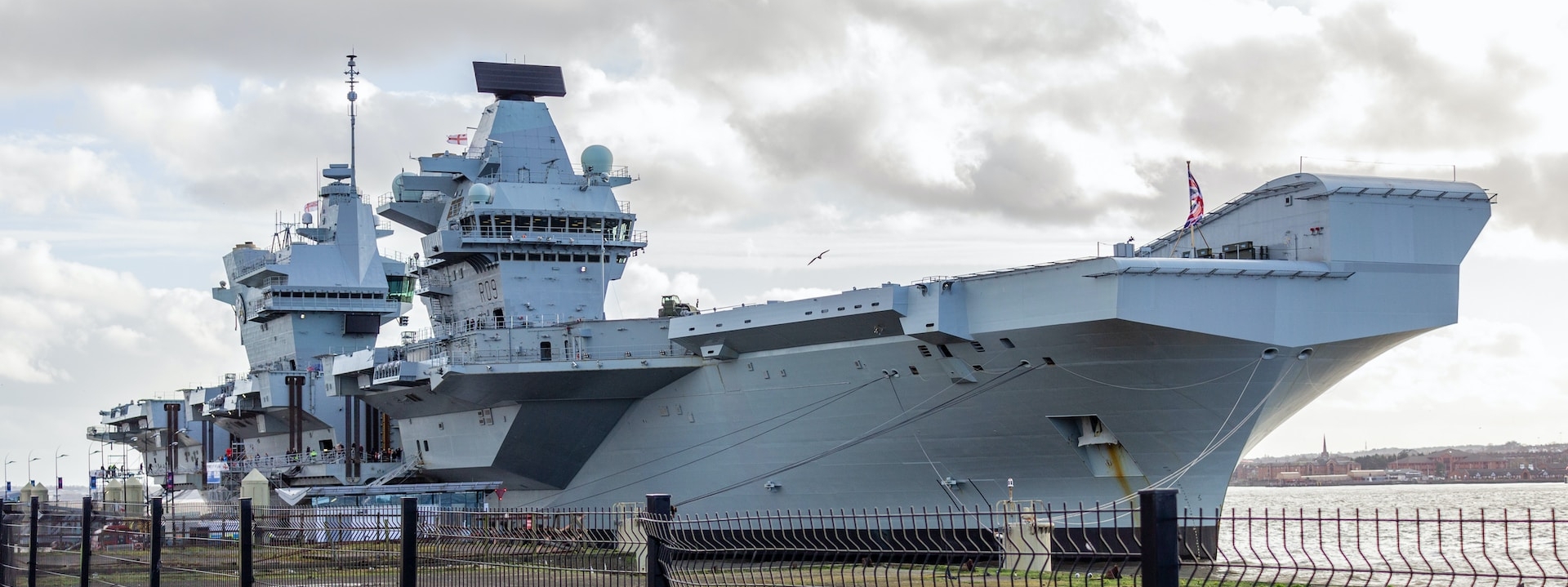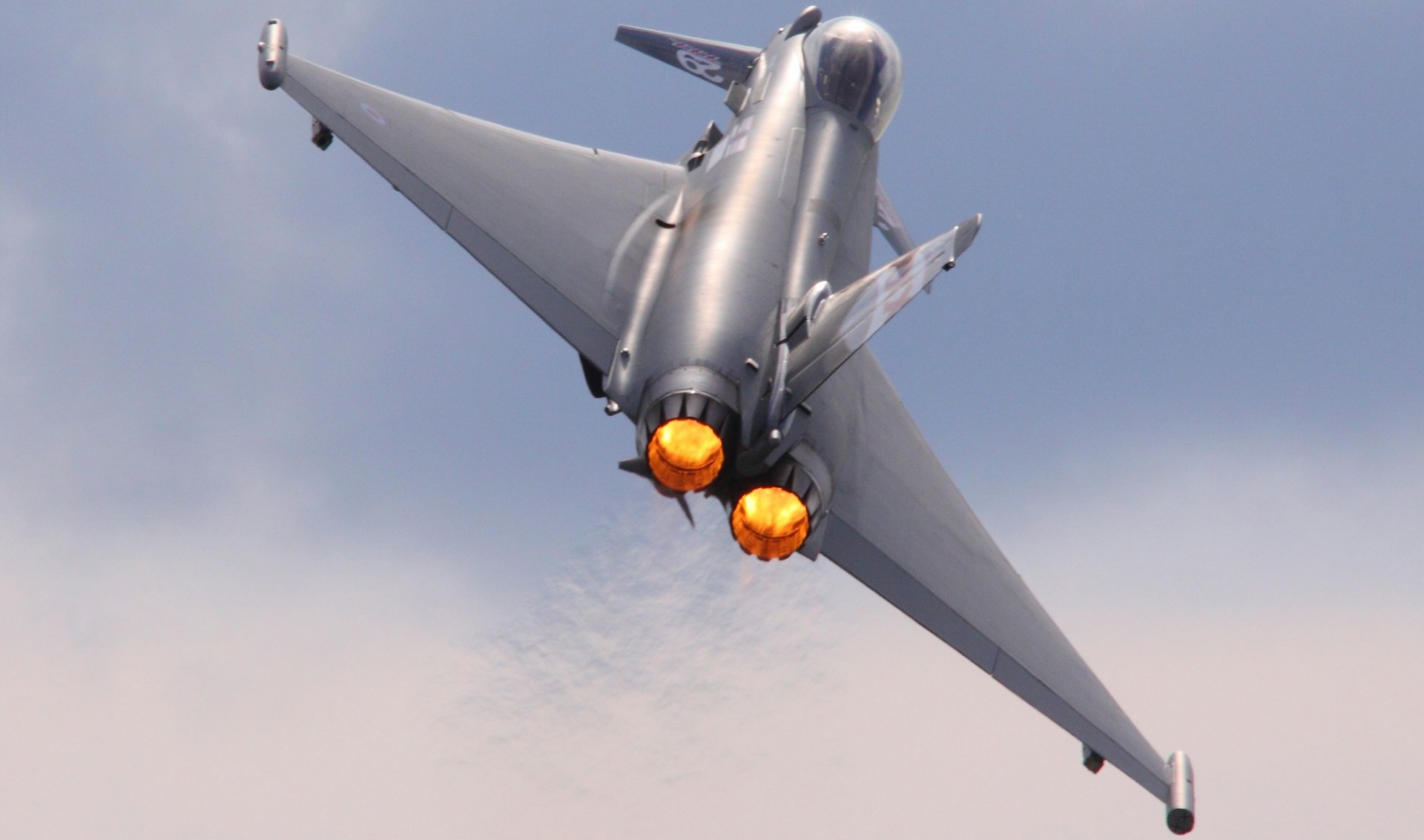Go far, or go home - the UK's Carrier Conundrum

The UK's Queen Elizabeth Class aircraft carriers were originally conceived nearly 30 years ago when the world, and our perception of it, was very different from today. Are they fit for purpose to face today's threats, and how should they be equipped for the future?
In the beginning, there was STOVL...
Studies into a replacement for the Invincible Class carriers began in the mid-nineties, with the contract finally announced by the then Labour Government in 2007, and placed with the Aircraft Carrier Alliance of BAE Systems, Babcock, Thales and A&P Group in 2008. The 1998 Strategic Defence Review declared "In the post Cold War world, we must be prepared to go to the crisis, rather than have the crisis come to us. So we plan to buy two new larger aircraft carriers to project power more flexibly around the world" and "Aircraft carriers will have a wide utility, including for deterrence and coercion. Our current INVINCIBLE class carriers will be given a wider power projection role by the development of a "Joint Force 2000" combining RN and RAF Harrier aircraft. To meet our longer term needs, we plan to replace our current carriers from around 2012 by two larger, more versatile, carriers capable of carrying a more powerful force, including a future carrier borne aircraft to replace the Harrier". It also predicted a change in emphasis for carriers from the limited air defence provided by the Sea Harrier to an offensive strike capability offering a "a coercive presence which may forestall the need for warfighting, as recently in the Gulf", later justifying the retirement of the Sea Harrier and focus on Harrier GR7 and GR9 operations from the Invincible Class.
The context at the time of course was that the Cold War had ended and there was no expectation of either a full-scale war in Europe or confrontation between major powers, with the Defence Review stating "On the positive side, the collapse of Communism and the emergence of democratic states throughout Eastern Europe and in Russia means that there is today no direct military threat to the United Kingdom or Western Europe. Nor do we foresee the re-emergence of such a threat".
The result of the studies to achieve the required sortie generation rate was a 65,000 tonne carrier designed to accommodate 36 combat aircraft plus helicopters for anti-submarine and airborne early warning. With the UK joining the Joint Strike Fighter programme as a Tier 1 partner and following the 2002 decision to initially operate the F-35B variant, the new carriers would be configured for STOVL operations with ski ramps. However, in order to provide maximum flexibility and future-proof the vessels they would be 'fitted for but not with' catapults and arrestor wires. Those of us of a certain age will recall the MOD boasting that a key selling point of the chosen design was the ease with which it could be modified with the addition of 'cats and traps', with the systems used in the US Nimitz Class specified.
2010 brings austerity, and catapults...
Following the 2008 financial crisis and a change of Government in 2010, the incoming Conservative administration ordered a new Strategic Defence and Security review. Despite a pressing need to cut Government spending, the review largely agreed with the previous Government's conclusion about the need for and role of aircraft carriers, and committed to completing the construction of both new vessels. Again, there was no expectation of fighting a large-scale war against a peer adversary, so the review concluded that only one operational carrier would be required to contribute to "an overall Force Structure geared towards helping deter or contain threats from relatively well-equipped regional powers, as well as dealing with insurgencies and non-state actors in failing states".
Nonetheless, the axe was falling elsewhere with the decision to immediately retire HMS Ark Royal and end carrier-based Harrier operations, cut the surface fleet of destroyers and frigates from 23 to 19, and cancel the Nimrod MRA4 maritime patrol aircraft.
The 2010 review was critical of the previous Government's decision to proceed with a STOVL-only configuration, and committed to installing catapults and arrestors at the expense of a delay in service entry. It is interesting to note that this decision at the time was driven by a desire for greater interoperability with both the US and the French, envisaging US and French aircraft operating from UK carriers, and UK aircraft operating from US and French carriers, with the eventual aim of joint Maritime Task Groups. Only a single F-35 variant would be purchased, and it was noted that the F-35C carrier variant of the Joint Strike Fighter had greater payload and range, and would be cheaper to operate with through-life costs expected to be 25% lower compared to the F-35B.
The 2010 review also retained a helicopter carrier in the form of either HMS Ocean or HMS Illustrious.
Catapults? That'll be 2 billion quid, Guvnor...
With construction of HMS Queen Elizabeth underway, the MOD tasked the Aircraft Carrier Alliance with scoping out that 'easy' conversion to cats and traps for the second vessel in the Class, HMS Prince of Wales, using the new Electromagnetic Aircraft Launch System (EMALS) from General Atomics. By 2012, the estimated cost had ballooned to £2bn, and the conversion time would delay completion of HMS Prince of Wales until 2023. Coupled with the decision to procure only the F-35C, that would substantially delay availability of carrier-based strike and in the meantime leave the Royal Navy with an enormous helicopter carrier in the form of HMS Queen Elizabeth.
Cynics at the time noted that BAE Systems, with a size 12 planted firmly in both the Aircraft Carrier Alliance and the F-35 camps, would have little self-interest in seeing F-18s or Rafale's operating from Royal Navy carrier decks, and Rolls Royce undoubtedly wasn't keen to sell fewer lift fans, so the decision was taken to revert to Plan A and complete both carriers in the STOVL configuration.
2014 did at least bring a Government decision to bring both carriers into Royal Navy service, rather than keeping one in 'extended readiness' or even selling it.
State-based threats and unrealised ambition...
The other thing 2014 brought was the original invasion of Ukraine by Russia, annexing Crimea and supporting separatists in the Donbas. The new UK Government in 2015 duly initiated a new Strategic Defence and Security Review, the first in over 20 years that found itself acknowledging "the resurgence of state-based threats", although it still came second to the threat of ISIS and instability in the Middle East in the Prime Minister's forward to the review. Looking back at it now, the 2015 review is strikingly ambitious by today's standards, re-committing to the eventual purchase of 138 F35s. It did however follow the 'ten year rule' - where the UK perennially plans on the basis that the next big war is 10 years away. In this case Future Force 2020 was superseded by Joint Force 2025, a "highly capable expeditionary force of around 50,000" comprising a Maritime Task Group centred on a QEC carrier and a land division with three brigades including a new Strike Force to "to tackle a wider range of more sophisticated potential adversaries". This was supported by a promise "to not reduce the Army to below 82,000, and increase the Royal Navy and Royal Air Force by a total of 700 personnel".
The UK's strategy for China at that time was to hug it close and build amicable relations with it, and the review doesn't mention either Taiwan or Hong Kong. I'll leave you to form your own opinion as to the extent to which the promises and aspirations of the 2015 review were delivered.
Coordinated tilting...
The 2021 Integrated Review, even before the renewed aggression in Ukraine, acknowledged "Russia remains the most acute threat to our security". China, having breached agreements regarding the status of Hong Kong, was described as "assertive". Nonetheless, noting the importance of trade with Asia and the vulnerability of 'choke points' in the South China Sea, the UK followed the US with an 'Indo-Pacific Tilt' and stating "Preserving freedom of navigation is therefore essential to the UK’s national interests". The clear implication being that the UK, acting with the US and regional allies, would be willing to deploy a military presence to deter and potentially respond to aggressive Chinese actions that threaten global trade. The first major overseas deployment of HMS Queen Elizabeth therefore took her to the South China Sea, and the review offered coordination with the French regarding carrier deployments to the Indo-Pacific.
This represented a significant change in UK defence posture since the requirement for the QEC aircraft carriers was first specified, and also presented a substantially different threat environment to that which they were designed for.
The tyranny of distance, the vulnerability of range...
For the UK to deploy a military force to the Indo-Pacific capable of conducting military action against a peer adversary, or even credibly deter an opponent, presents considerable difficulties. Firstly, the challenge of providing logistic support at such a distance, sufficient to maintain a war-fighting operational tempo, cannot be underestimated.
Secondly, the severe limitations of STOVL operations would soon become very apparent. China has long been aware that US support to Taiwan is heavily dependent on carrier operations, and has responded by investing in long range anti-ship weapons including the DF-21D "carrier killer" anti-ship ballistic missile with an estimated range of over 900 miles. Russia meanwhile is developing long range hypersonic anti-ship missiles, and there are no guarantees such technologies won't proliferate in the future. The US response to this threat is to provide carrier-based in-flight refuelling capability, currently from F/A-18E/F buddy aircraft equipped with Cobham's Aerial Refuelling Store and in the future from the Boeing MQ-25 Stingray or similar autonomous Unmanned Air Systems. This capability greatly increases the combat radius of US Navy aircraft and allows the carrier to be stationed beyond the range of such weapons.
The UK, currently hampered by operation of the shortest-range F-35 variant and without any organic in-flight refuelling capability, could not conduct strike operations against Chinese targets without putting the carrier well within range of these anti-ship threats. Also, the need for airborne surveillance to be performed by rotorcraft (currently) or possibly fixed-wing STOVL UAS in the future also limits the range and endurance of those assets and restricts situational awareness.
Catapults again, sort of, maybe...
In 2021, the UK MOD issued a new RFI looking at the availability of electromagnetic catapult and arrestor wire systems to launch aircraft. However, the maximum aircraft launch weight was specified as 24,949 KG, somewhat below the maximum take-off weight of the F-35C carrier variant.
This implies that the aim isn't to abandon STOVL combat aircraft operations with the F-35B and achieve greater interoperability with the US and French Navies, but to provide the capability to launch future fixed-wing UAS aircraft that could provide in-flight refuelling as well as AEW and ISTAR at extended ranges from the host carrier.
Retaining the STOVL F-35B means retaining the ski ramp, so it will be interesting to see how the MOD expects to integrate the electromagnetic launch capability onto the QEC without removing the ramp. Will it adopt the novel approach of catapulting aircraft up the ski ramp, or launch to one side of it?
Conclusion - go far, or go home...
The world has changed considerably since 1998 when the review boldly stated that there was no direct military threat to the UK or Western Europe, while China's recent activities have come close to acting as a blockade of Taiwan. As currently configured and equipped, it is difficult to see how the Royal Navy can credibly play a part in preserving freedom of navigation in the South China Sea should China choose to attempt an invasion of Taiwan, or simply cause economic disruption to the West by interfering with trade and shipping.
An effective carrier capability for the 21st Century requires a more capable fleet of aircraft able to operate at greater stand-off ranges, something than will not be achieved with STOVL aircraft alone. Adding catapult-launched UAS to operate alongside STOVL F-35Bs might be a step in the right direction, but maybe it's time to bite the bullet and commit to a full 'flat top' conversion programme with cats and traps for the UK's QEC carriers and switch future aircraft orders to F-35C variants? Either that, or accept that we will be entirely dependent on the US and regional allies to protect our interests in the Indo-Pacific.

